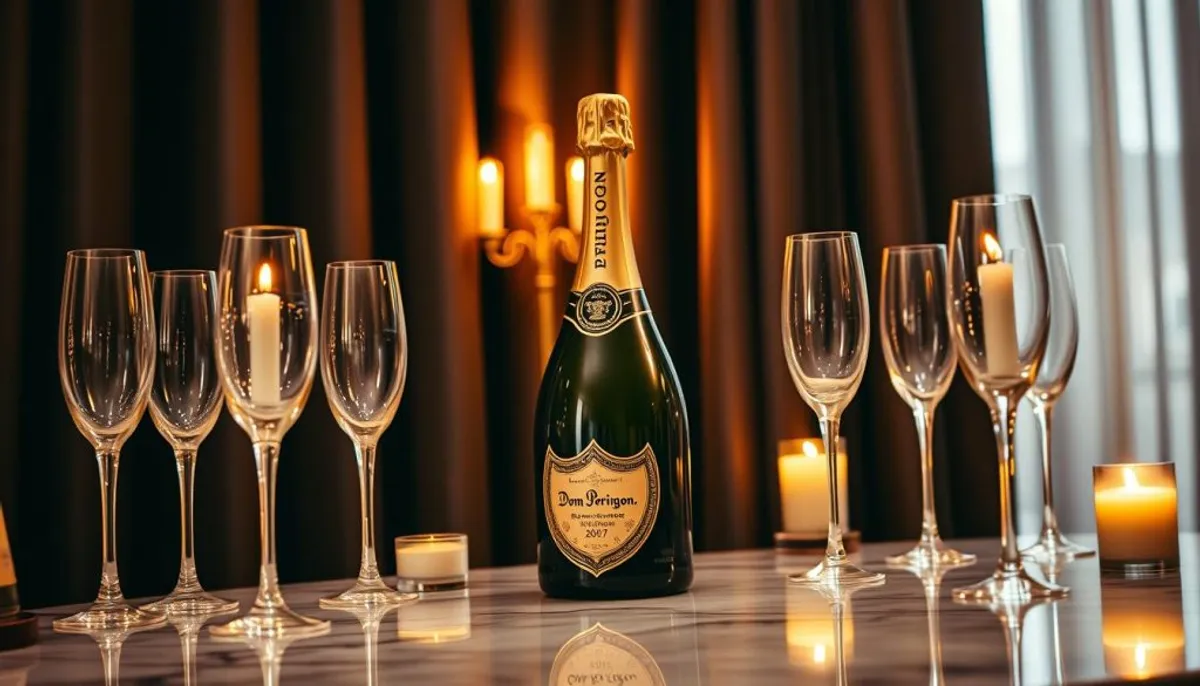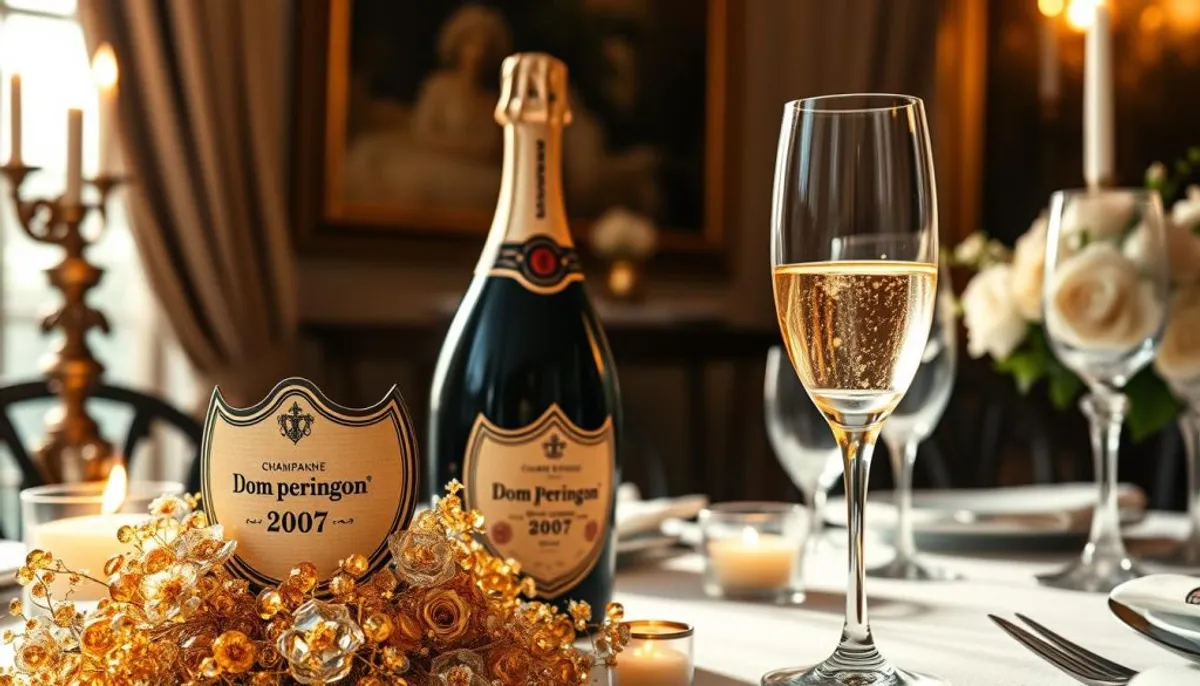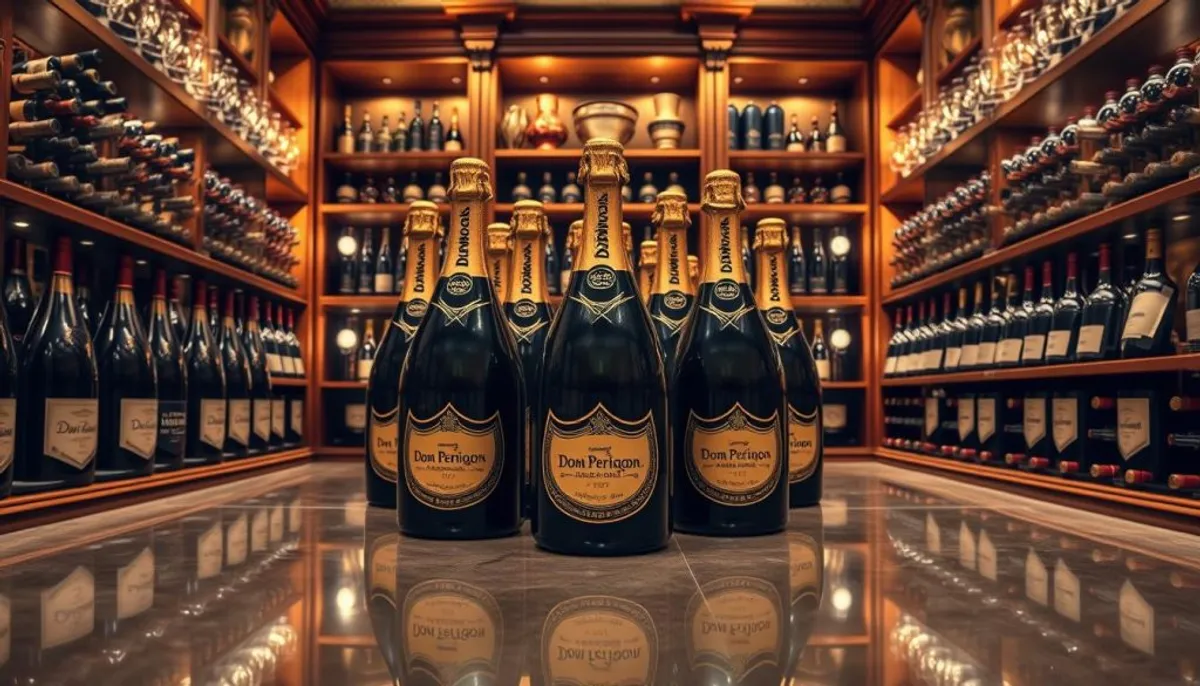Enter the realm of luxury champagne with Dom Perignon’s 2007 vintage. This champagne epitomizes the zenith of winemaking expertise. It embodies Dom Perignon’s dedication to creating single-year masterpieces.
Dom Perignon’s methodology diverges from other esteemed houses like Krug. While Krug blends up to 400 wines for their Grand Cuvée, Dom Perignon aims to capture the essence of a single year. This philosophy is evident in the 2007 vintage, offering a distinct taste of that year’s harvest.

The 2007 Dom Perignon is distinguished by its profound aromas and intricate flavors. It exemplifies the house’s rigorous grape selection and adept blending techniques. This vintage is now accessible for wine aficionados globally, available through champagne-export.com.
Key Takeaways
- Dom Perignon 2007 represents the peak of champagne craftsmanship
- It showcases the unique characteristics of the 2007 harvest
- Dom Perignon only produces vintage wines from single years
- The 2007 vintage offers intense aromas and complex flavors
- This exceptional champagne is now available for global export
The Legacy of Dom Perignon Champagne
Dom Perignon’s history is a tapestry of tradition and excellence. This luxury champagne brand’s origins date back to 1668, solidifying its role in champagne heritage. The narrative commences at the Abbey of Saint-Pierre d’Hautvillers, where a monk’s unwavering dedication to winemaking redefined champagne’s trajectory.
Origins at Abbey of Saint-Pierre d’Hautvilliers
Dom Pierre Pérignon, a Benedictine monk, held the position of cellar master at the abbey until 1715. His innovations in monk winemaking were groundbreaking. He championed the use of only the finest grapes from Champagne’s elite vineyards, a principle that remains at Dom Perignon’s core.
The Monk’s Winemaking Philosophy
Dom Pérignon’s winemaking philosophy was visionary. He employed natural methods, including cool-temperature harvesting and smaller yields to guarantee quality. This commitment to excellence established the groundwork for a champagne brand of unparalleled prestige.
Evolution into a Luxury Brand
Dom Perignon’s transformation from its modest beginnings to a luxury icon is remarkable. The brand exclusively produces vintage champagne, eschewing years where grape quality falls short. This unwavering dedication to quality has cemented Dom Perignon’s status among the world’s most influential brands, as recognized by Forbes. With nearly 60,000 cases shipped to the US in 2017, Dom Perignon’s legacy continues to shine brightly.
Understanding Dom Perignon’s Unique Approach
Dom Perignon distinguishes itself in the realm of vintage champagne through its distinctive winemaking philosophy. This luxury wine production entity adopts a bold strategy, diverging from the conventional methods employed by other champagne producers.
The Single Vintage Philosophy
The core of Dom Perignon’s winemaking is its adherence to the single vintage philosophy. Unlike many counterparts that blend wines from various years, Dom Perignon crafts each bottle from grapes harvested in a single year. This singular focus has resulted in the creation of 47 white vintages up to 2015, with the earliest dating back to 1921.
Commitment to Excellence
Dom Perignon’s unwavering dedication to quality is reflected in its selective production. From 1921 to 2013, only 45 vintages were released. The house is not hesitant to forego years when the grapes do not meet their stringent standards. This rigorous approach ensures that each bottle of Dom Perignon embodies the pinnacle of its vintage.
Expert Blending Techniques
While adhering to the single vintage rule, Dom Perignon excels in champagne blending. The house typically combines Chardonnay and Pinot Noir grapes, with each vintage showcasing a unique balance. For their rosé champagne, more than 20% blended still red wine is added, creating an intense flavor profile. The champagne chardonnay flavors are particularly notable, adding depth and complexity to the overall experience.
| Aspect | Detail |
|---|---|
| White Vintages (up to 2015) | 47 |
| Rosé Vintages (up to 2023) | 28 |
| Minimum Aging Period | 7 years |
| Main Grape Varieties | Chardonnay and Pinot Noir |
Dom Perignon’s unique approach to vintage champagne production harmoniously blends tradition with innovation. By focusing on single vintages, maintaining strict quality standards, and mastering the art of blending, Dom Perignon continues to create exceptional champagnes that capture the essence of each harvest year.
Dom Perignon 2007: A Remarkable Year
The 2007 vintage champagne occupies a distinctive niche in Dom Perignon’s annals. Anticipation for the Dom Perignon 2007 was palpable, yet the house defied expectations. They made a groundbreaking choice, electing not to produce a 2007 vintage. This bold stance underscores their unyielding commitment to quality.
This decision underscores Dom Perignon’s relentless pursuit of excellence. Rather than settle for mediocrity, they chose to concentrate on vintages that epitomize their lofty standards.
The decision to forego a Dom Perignon 2007 release is a testament to the house’s ethos. It showcases their preference for quality over quantity, even if it entails forgoing a year. This strategy ensures that every Dom Perignon bottle upholds the brand’s esteemed reputation for quality.
Though the 2007 vintage did not meet Dom Perignon’s stringent criteria, it laid the groundwork for future triumphs. The house’s unwavering dedication to vision over vineyards has consistently yielded remarkable champagnes. Vintages such as 2008 and 2009 have garnered widespread acclaim.
| Year | Notable Characteristics | Release Status |
|---|---|---|
| 2007 | Not up to Dom Perignon standards | Not released |
| 2008 | Likened to the 1996 vintage, needing more time | Released after 2009 |
| 2009 | Ripest vintage since 2003 | Released before 2008 |
The Art of Vintage Selection
Dom Perignon’s champagne vintage selection is a meticulous process that sets the standard for excellence in the industry. The house’s commitment to quality shines through every step of their production.
Weather Conditions and Harvest Timing
The grape harvesting process is heavily influenced by weather patterns. Dom Perignon’s experts closely monitor climate conditions throughout the growing season. They determine the optimal time for harvest, ensuring grapes reach peak ripeness.
Grape Selection Process
Dom Perignon works with numerous family grape growers, each tending to specific plots. After harvesting, each plot is vinified separately. This allows for a nuanced understanding of the year’s yield. The winemakers taste each plot individually, selecting only the finest for potential inclusion in the final blend.
Quality Control Measures
Rigorous wine quality control is a hallmark of Dom Perignon production. Each grape undergoes careful inspection before entering the winemaking process. This ensures only the highest quality fruit contributes to the vintage, a principle that is also reflected in the work of marc hebrart.
| Quality Control Step | Purpose |
|---|---|
| Visual Inspection | Remove damaged or unripe grapes |
| Sugar Content Testing | Ensure optimal ripeness |
| Acidity Measurement | Balance flavor profile |
| Tasting Panels | Verify overall quality and character |
This careful approach to vintage selection and quality control is why Dom Perignon consistently produces exceptional champagne. Each bottle represents the pinnacle of the house’s craft and the unique character of its vintage year.
Tasting Notes and Flavor Profile
The Dom Perignon 2007 tasting notes unveil a champagne of unparalleled quality. Its vintage characteristics are evident in its intricate flavor profile, garnering a remarkable 94 points. Ranked among the top 1,399 wines globally, it exemplifies Dom Perignon’s dedication to excellence.
The champagne’s flavor profile is a sensory odyssey. It offers a delicate balance of fruitiness and acidity, with hints of lemon cream, honey, and tropical fruits. The wine’s structure is both lithe and elegant, a testament to Dom Perignon’s mastery.
Experts recommend Lehmann Grande Champagne glasses to fully appreciate this vintage’s subtleties. As it evolves in the glass, new layers of complexity emerge, culminating in a long, persistent finish that lingers on the palate.
| Aspect | Description |
|---|---|
| Color | Medium |
| Nose | Refined |
| Taste | Balanced |
| Finish | Endless |
While the Dom Perignon 2007 is impressive, its rosé counterpart from the same year surpasses it with a stellar 97-point rating. Both hail from Reims, Champagne, highlighting the region’s excellence in vintage champagne production.
The Plénitude Concept
Dom Perignon Plénitude embodies a groundbreaking approach to aged champagne. It illustrates the evolution of vintage champagne through three distinct phases. This concept embodies Dom Perignon’s dedication to excellence and innovation in winemaking.
First Plénitude (P1)
The initial release of Dom Perignon occurs after about nine years of aging. This First Plénitude captures the champagne’s youthful energy and promise. It presents a harmonious blend of flavors, reflecting the vintage’s character and the winemaker’s skill.
Second Plénitude (P2)
P2 marks a significant transformation in the champagne’s development. Released after 16 to 20 years, this stage showcases enhanced complexity and vibrancy. The P2 expressions are known for their intensity and precision, with flavors that have evolved and deepened over time.
Third Plénitude (P3)
The rarest and most prestigious expression, P3 is released after 25 to 40 years of aging. This final stage represents the pinnacle of Dom Perignon’s maturation process. P3 champagnes offer unparalleled refinement and integration of flavors, embodying the living memory of the vintage.

| Plénitude | Aging Period | Characteristics | Price Range |
|---|---|---|---|
| P1 | 9 years | Youthful, harmonious | $150-$170 |
| P2 | 16-20 years | Complex, intense | $300-$400 |
| P3 | 25-40+ years | Refined, integrated | $600-$1000+ |
The Plénitude concept allows wine enthusiasts to experience the remarkable journey of Dom Perignon through time. Each stage offers a unique expression of the vintage, showcasing the champagne’s ability to evolve and gain complexity with age.
Cellaring and Storage Recommendations
Proper champagne storage is essential for aging Dom Perignon to its full potential. The ideal environment is a cool, dark space with consistent conditions. Aim for a temperature between 45°F and 65°F, with 55°F being the sweet spot. Humidity should be between 70% and 85% to prevent cork drying and oxidation. Additionally, when selecting your bottles, consider our top champagne picks for the best options available.
For wine cellaring, position bottles horizontally to keep the cork moist. This method prevents air from spoiling the champagne. Additionally, exploring the various champagne chardonnay flavors can enhance your tasting experience. Avoid vibrations and sudden temperature changes, as they can disrupt the aging process.
Dom Perignon 2007 boasts excellent aging potential. While non-vintage champagnes typically age for 3-4 years, vintage Dom Perignon can age beautifully for 5-15 years or more under proper storage. For long-term aging, consider magnum bottles. They allow for a more gradual development of complex flavors, including the distinct champagne chardonnay flavors, and finer bubbles.
| Storage Factor | Recommendation |
|---|---|
| Temperature | 55°F (45°F – 65°F range) |
| Humidity | 70% – 85% |
| Position | Horizontal |
| Environment | Dark, vibration-free |
By adhering to these guidelines, you’ll ensure your Dom Perignon 2007 reaches its full potential. It will develop intricate flavors and aromas over time. Remember, proper storage is crucial for enjoying this exquisite champagne at its best.
Food Pairing Suggestions
Dom Perignon food pairings unveil a realm of gourmet wine pairings, enhancing any dining occasion. The 2007 vintage, celebrated for its superior quality, excels when matched with appropriate dishes. Notably, marc hebrart has contributed to the understanding of these pairings. We will examine some captivating champagne and cuisine pairings that promise to tantalize your taste buds.
Classic Pairings
Dom Perignon 2007 harmonizes exquisitely with seafood. Its sharp acidity perfectly complements oysters, scallops, and prawns. For an opulent indulgence, pair it with caviar or lobster. The champagne’s effervescence effectively counteracts rich flavors, refreshing the palate between each morsel.
Contemporary Combinations
For innovative pairings, consider Dom Perignon with sushi or sashimi. The wine’s complexity elevates the subtle flavors of raw fish. Aged cheeses present another intriguing pairing, with the champagne’s bubbles harmonizing the creamy textures. For a delightful surprise, pair it with truffle popcorn – the earthy truffle notes complement the wine’s nuanced flavors.
Special Occasion Menus
Design a memorable meal centered around Dom Perignon 2007. Begin with light appetizers such as ceviche or goat cheese crostini. Progress to a main course of roasted chicken or grilled sea bass. Conclude with a fruit tart or crème brûlée for dessert. This versatile champagne enhances each course, transforming every bite into a celebration.
| Course | Dish | Pairing Notes |
|---|---|---|
| Appetizer | Oysters | Classic pairing, enhances brininess |
| Main | Roasted Chicken | Complements richness, refreshes palate |
| Dessert | Fruit Tart | Balances sweetness, adds brightness |
Investment Value and Collection Potential
Dom Perignon investment has emerged as a profitable endeavor for both wine aficionados and investors. The 2007 vintage exemplifies the brand’s potential in the realm of vintage champagne collecting. Its exceptional quality and limited production make it a unique opportunity for those seeking to diversify their investment portfolios.
The Champagne market has witnessed remarkable growth, outperforming other wine regions. The Champagne 50 index, a pivotal indicator of market trends, has seen an 11.43% increase over the past year. This growth underscores the robust demand for premium champagnes, such as Dom Perignon.

Wine auction values for Dom Perignon have consistently appreciated over time. For example, older vintages have experienced significant price increases. The correlation between age and value is striking, with champagnes over 20 years old averaging $3,500 per case, compared to $2,100 for younger wines.
| Vintage | Price Increase | Annual Return | Expert Ratings |
|---|---|---|---|
| 2005 Jacques Selosse Millesimé | 278% in 5 years | 30% | 96 pts (Richard Juhlin), 95 pts (Wine Advocate) |
| 2002 Salon | 225% in 5 years | 27% | 97 pts (Vinous), 95 pts (Wine Advocate) |
| 2009 Louis Roederer Cristal | 138% in 7 years | 13% | 96 pts (Vinous), 97 pts (James Suckling) |
| Dom Pérignon P2 1996 | 98% in 5 years | 15% | 97 pts (Vinous), 95+ pts (Wine Advocate) |
For those interested in vintage champagne collecting, Dom Perignon 2007 presents an enticing prospect. Its potential for appreciation, coupled with the brand’s prestigious reputation, makes it a valuable addition to any fine wine collection. As with any investment, proper storage and patience are crucial to maximizing returns in the dynamic world of wine auction values.
Conclusion
Dom Perignon 2007 exemplifies the pinnacle of luxury champagne export, offering a glimpse into unparalleled excellence. This vintage embodies the essence of Dom Perignon’s single vintage philosophy. It showcases the unique character of a year that defied expectations in Champagne.
Initially viewed as a lackluster year, Dom Perignon’s winemaking team transformed it into a triumph. The result is a premium wine selection with intense gold shimmer. It features primary aromas of honey and brioche, alongside delicate notes of mirabelle plum and fresh hazelnut. Its complexity and aging potential rival even the legendary 1996 vintage.
Dom Perignon 2007’s availability through champagne-export.com opens doors for collectors and connoisseurs worldwide. Whether enjoyed now or cellared until 2032, this vintage promises an unparalleled experience. It stands as a testament to Dom Perignon’s legacy, proving that true mastery can create magnificence even in challenging years.
RelatedRelated articles



